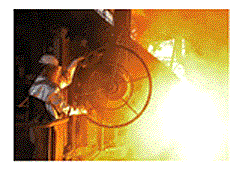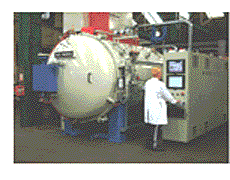
Heat-treating is defined as the controlled heating and cooling of a metal in order to change its physical and mechanical properties without changing its shape. A material often hardens or changes characteristics as a result of some sort of process that has been performed, such as machining or welding and is therefore an unintended consequence that will most likely need to be relieved in some way to bring it back to its previous form.
Several types of heat treatments may be used at various stages in a part’s life. It is often associated with the ability to increase the strength of a metal such as cast iron, steel, aluminum or some other alloy, but it is a process that can also be used to improve machining and formability, and restore ductility after a cold working operation. Therefore, heat treating can be very beneficial to the manufacturing process and can help improve product performance by greatly increasing material strength.

If you thought your CNC machine was expensive, try pricing a furnace that heats up to 2,000° F! While it is unlikely that very many engine builders will want to purchase a heat treating furnace or vacuum tempering oven for their shops’ needs, it is important to have knowledge of the parts that you may be working with, machining and welding on day-in and day-out. Although some of you may decide to outsource your heat treating needs for things like cryogenic treatments (although not technically a heat treatment, it is similar. More on this later), most of the parts you work with have been heat treated already from the manufacturer and it’s up to you to keep the components in its strongest form.
When we talk about heat treating it is a general term that covers many methods to treat various metals such as aluminum and steel as well as others. Iron and steel are the easiest to heat treat because of their high carbon content but other alloys and composites may be heat treated also, however, for purposes of this article we’ll stick with aluminum and steel because they are most common in engine components.
Steel
Hardening/quenching – this is done to strengthen the material and also to increase the wear properties of the metal. Steel is made up of iron and carbon. During its formation, steel can only dissolve a certain amount of carbon while the rest turns into graphite. When steel is heated, it will harden at around 1,500° F (depending on the exact mixture of the alloy) and transform the atoms from the center to the face of a molecule. This transformation happens at the austenite melting point during the heating process, which is the point at which the material melts and absorbs to become one solid. Once the carbon is dissolved, the part must then be rapidly cooled (quenched) to trap the carbon structure in its new form. As the atoms try to push back to their original form, this stress is what creates the hardness in the metal. By varying the rate of quenching, the metal’s grain size and grain patterns are controlled to produce different levels of hardness and tensile strength. For the most part, the faster the metal is quenched, the smaller the grain size will be, making the metal harder. And as hardness and the strength of the metal increase, toughness and ductility will decrease. Typically, steel components are quenched in oil or water but there are other methods as well, including salt baths and others.
Softening – this process is to reduce strength or hardness of the material and to remove residual stresses, improve toughness, restore ductility, refine grain size or change the electromagnetic properties of the material. It is most often necessary to remove any residual stresses that may have resulted from performing cold working operations such as cold rolling (such as with fasteners) in order to restore the ductility in the metal.
Annealing – is the process of making metal softer while producing uniform material properties. By heating a metal to a specific temperature and then letting the material cool slowly to room temperature, the component’s structure will become more relaxed and the stresses caused by machining or welding will have been relieved for better fatigue resistance. A full anneal is when the component is slow cooled in an oven over a long period.
Normalizing – this process also softens the metal components but it’s different from the full anneal process in that the metal is relaxed by allowing it to cool in the air for several hours until it reaches room temperature. Normalizing does not produce quite the same level of uniformity in the metal as full annealing does but it is considered an easier, less expensive method because the process does not require oven time.
Tempering – is when you heat a quench-hardened or normalized metal to a temperature below the transformation range to produce the desired properties. The object of tempering or “drawing” is to reduce the brittleness in hardened steel and to remove the internal strains caused by the sudden cooling in the quenching bath. The tempering process consists of heating the steel by various means to a certain temperature and then cooling it.
Cryogenics – When discussing heat treatment, cryogenic treatment must also be included. One may wonder why, since heat treatment is done with extremely high temperatures, and cryogenic treatment is done with extremely low temperatures reaching minus 300° F. Because of this, we contacted Bob Reed, Motorsports Division Manager for the past 13 years at 300 Below, Inc. in Decatur, IL. “Cryogenic treatment does not take the place of heat treatment, rather, it completes what the heat treater started,” explains Reed.
“When heat treating, the temperature is increased to the proper ‘high’ temperature for the type of metal being treated. At the correct time, the parts being heat-treated are put in ‘the quench,’ at which time the temperature begins to decrease. It is during the quench that the improvement actually takes place. Parts become cooler and cooler, and better and better. The heat treater considers the treatment completed when the temperature of the parts reach room temperature.
Heat treatment is great, but there is nothing magical about room temperature, says Reed. It is at this time that the heat treated parts can be cryogenically treated, because when cryogenic treatment is properly performed, cryogenic treatment begins at room temperature, and through computer-control drops at the rate of one degree per minute until the temperature reaches 300° F. Small drill bits, sewing machine needles and guitar strings can be cryogenically treated at the same time as big engine blocks, gears, pumps, etc., but the treatment time must be based on the biggest, thickest cross-section. In other words, cryogenic treatment is not a surface treatment. The entire thickness is treated and receives the benefit which is normally improved performance, reduced wear and breakage, longer between rebuilds or replacement, reduced costs, and (hopefully) a more successful motorsports season.
Cryo processing also is used to stabilize aluminum and other non-ferrous metals. Cryogenic tempering conditions the aluminum so that large temperature variations can be tolerated with minimal distortion.
Stress relieving is another way to soften and relax the metal components. However, stress relieving doesn’t change the metal’s properties in the same way as other softening processes like full annealing or normalizing. Metal components can be stress relieved by heating to a specific temperature that is lower than the temperature to anneal or normalize the part. This process is typically used on materials and components that have been stressed during fabrication. Many heat treatment and welding processes create stress in the metal, which can lead to warpage after the heat-treating process or during subsequent machining operations. You should pay extra attention to weldments and the stresses that are induced by welding. In many cases, you should stress relieve a weldment that is to be machined because if you remove stressed material it will redistribute internal stress and may cause the part to warp.
Aluminum
Aluminum is heat treated differently than steel and, while it is not as easy to harden this non-ferrous metal, it can be softened without much difficulty. In fact, it is so easy to anneal aluminum that engine builders must be cautious when heating aluminum heads and other aluminum components in an oven for cleaning or straightening purposes because if exposed to too much heat for too long, the part will lose temper.
Hardening – to harden aluminum there are a few methods that are used. One method is to cold work the material. Cold working may, in some cases, be an unintended consequence of machining aluminum. Another way that aluminum is hardened is with a solution heat treatment where chemicals are diffused into the component to to create the desired characteristics. Aluminum is typically tempered to a hardened state and is rated in several levels of hardness and strength. A T4 tempered aluminum component has less hardness but more ductility, whereas a T6 or T7 temper may be harder but also more brittle.
Softening – as we mentioned earlier, aluminum is more prone to softening than to hardening. In a softened, annealed state, aluminum components do not have as much hardness or toughness but they do have ductility and formability. It is therefore a tradeoff between which properties are most desired for the application.
T4: Solution heat-treated and naturally aged to a substantially stable condition. This tempering applies to components that are not cold worked after solution heat-treatment or in which the effect of cold work from flattening or straightening may not be recognized in applicable specifications.
T5: Artificially aged only, and is applied to products which are artificially aged after an elevated-temperature rapid-cool fabrication process, such as casting or extrusion, to improve mechanical properties or dimensional stability, or both.
T6: Solution heat-treated and then artificially aged. Applies to components which are not cold worked after solution heat-treatment, or in which the effect of cold work in flattening or straightening may not be recognizable in the specified applications.
Randy Winberg of Winberg Crankshafts in Denver, CO, who builds custom crankshafts for many top drag racing and stock car teams, says his company does its own in-house heat treating, a process he terms a “quench and temper” treatment.
“It’s a quench and temper but it’s austenitizing at a certain temperature in the 1,500° F range, then a quench and then a temper after that,” says Winberg. “There are many variables with the temper and the type of material you use, but the temperature is what dictates the hardness. The lower temperature will be harder and the higher temperature will be a little bit softer.”
Winberg explains: “On the first phase of the heat treatment, we’re talking about core hardness, so it’s that hardness all the way through. We start out with an annealed billet and then we rough the shape of the crankshaft. Then we do the first phase of the heat treat to get the desired core hardness. Next we go through the entire machining process after the heat treat. After that, we have a series of stress relief cycles followed by a final nitride treatment that is really just a surface treatment.”
Winberg concludes, “We do a nitride surface treatment process for the final step. Nitriding is a diffusion process and there are several ways to do this. For example, there’s salt bath, fluidized bed and straight gas nitriding. But we prefer the latest technology: ion-plasma nitriding.”













